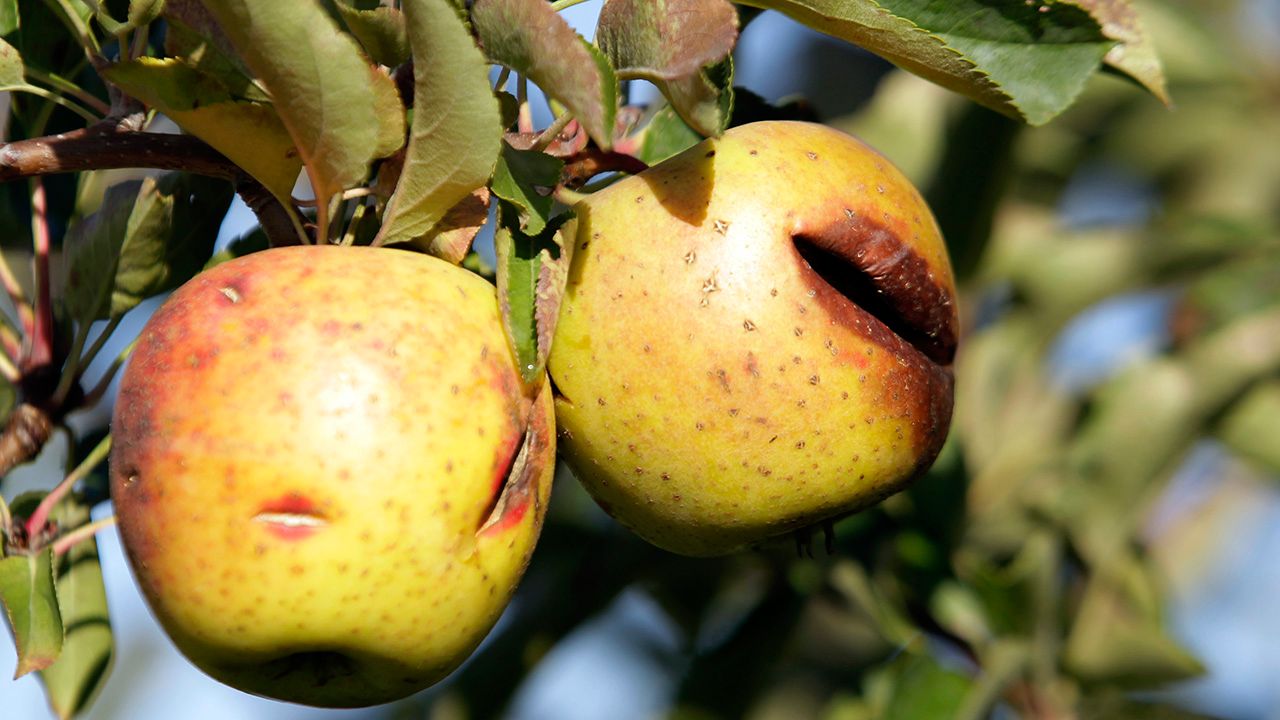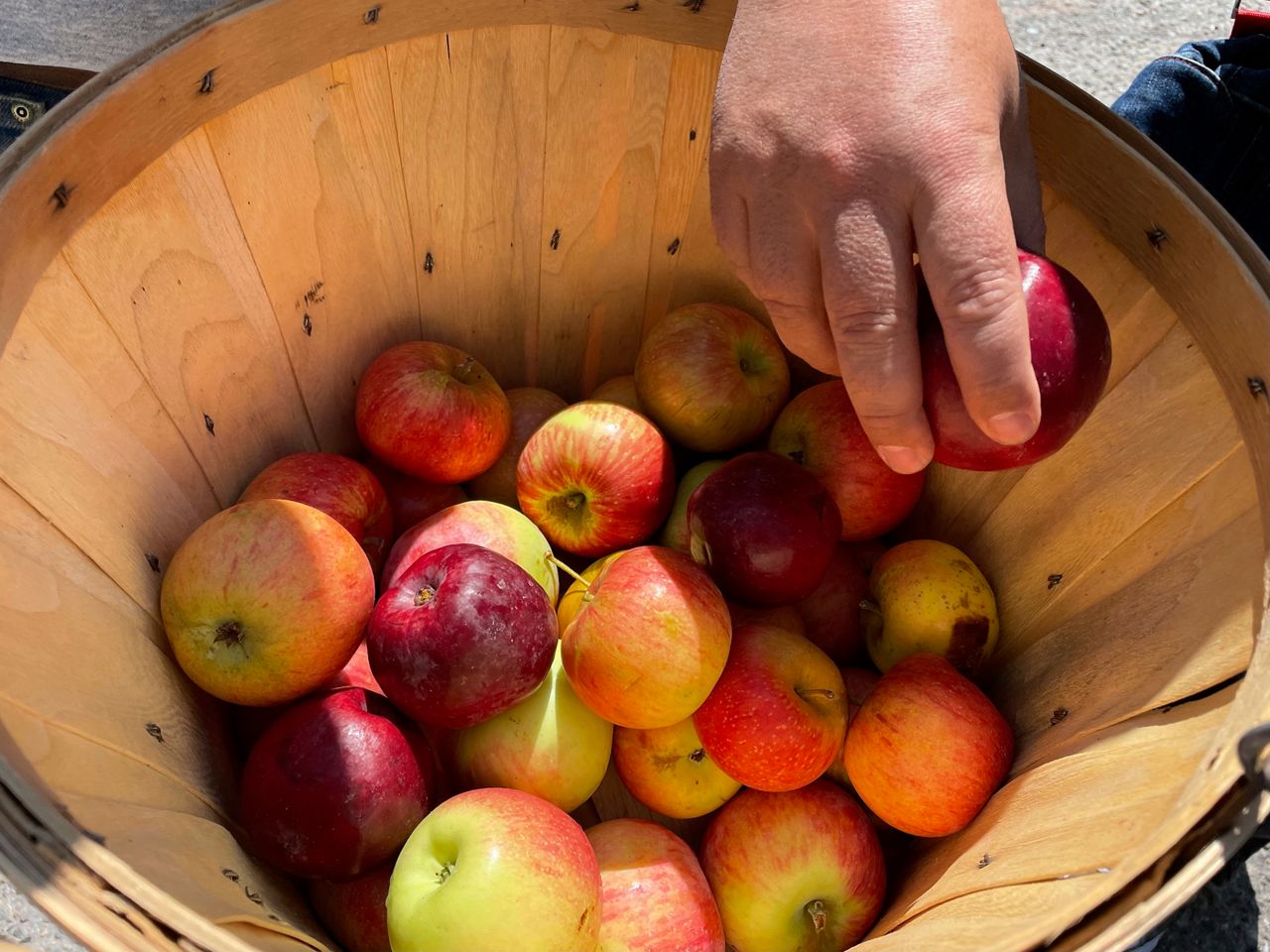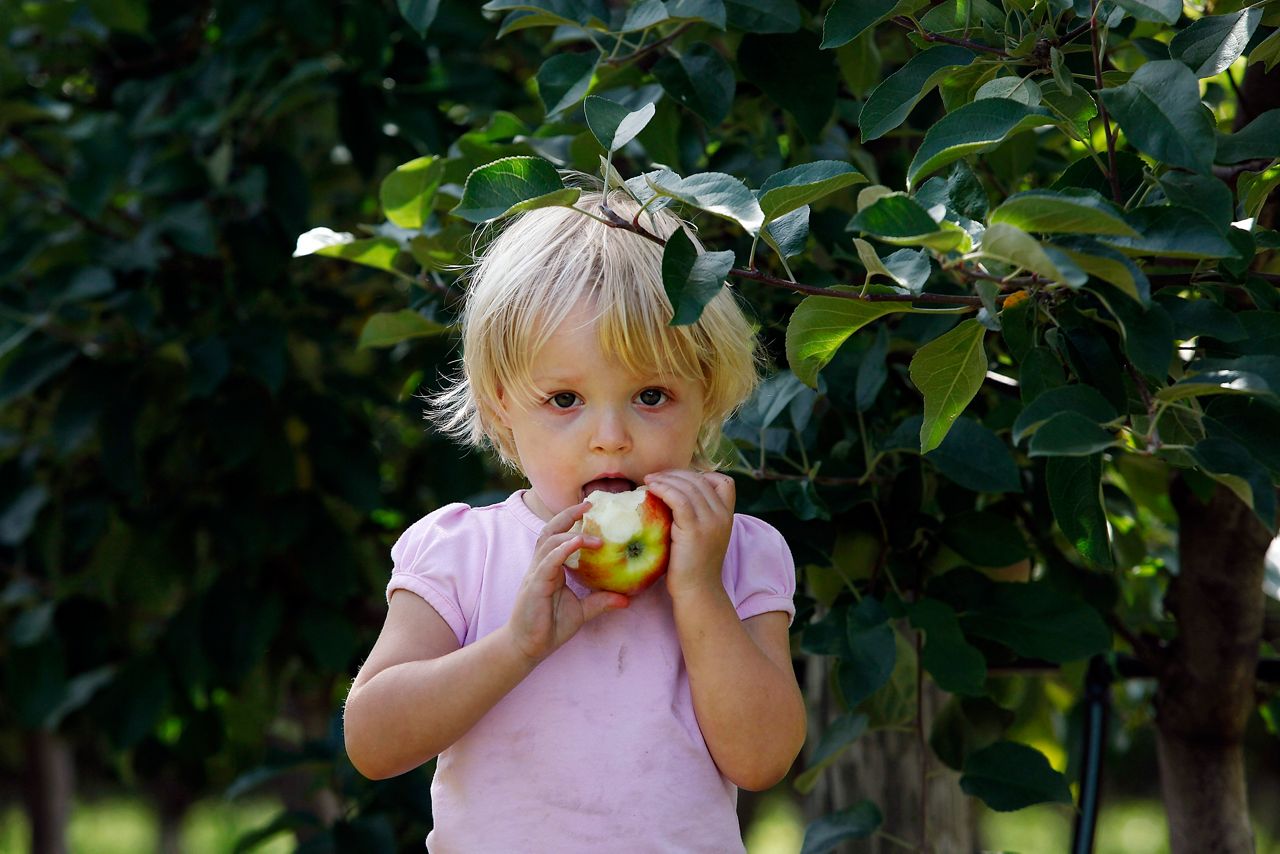Fall is here and apple picking season is in full swing. Whether you already went, or still plan to take a trip to your local orchard soon, you may notice some differences with this year’s crop.
From bloom to harvest, the weather patterns in between play an important role in determining the quantity and quality country’s most consumed fruit.
There’s no denying that apple picking is a fall favorite. Millions of of Americans take part in the annual tradition each year, craving time out to spend with family and friends at the orchard. Along with plenty of photo ops and recent memories, the best part is taking that first big bite into that freshly picked apple.
Toddler bites into a freshly picked apple from an orchard in Natick, Massachusetts. (AP Photo/Stephan Savoia)
Chewing our way down to the core, our senses are awakened. We consider the apple’s size, firmness, texture and flavor- most of which are determined by the weather patterns leading up to the harvest.
Weather at the core of it all
In 1998, apple crop production reached an all-time high in the U.S. With a number of factors contributing to this, ideal weather conditions spanning across the country during the growing season resulted in record-breaking yields that following fall. See the National Oceanic and Atmospheric Administration’s (NOAA) Annual 1998 National Climate Report here.
Unfortunately, that’s not always the case. Powerful storms or any other extreme weather events could disrupt the crop during its growing phase, inevitably affecting the apples that make it to harvest.

Apples damaged by drought and an early season frost in Indiana during the fall of 2012. (AP Photo/Michael Conroy)
Specifically speaking, drought bears a tough burden on the crop, influencing everything from its taste, size and overall health of the fruit itself.
Terance Robinson, a professor of horticulture at Cornell University, claims that drought conditions won’t necessarily affect the quantity of apples produced in the fall, but rather the size.
“Summers with ample rainfall result in large fruit size and excellent quality,” according to Robinson.

An orchard in New Mexico harvested smaller apples in 2021 due to drought conditions. (AP Photo/Susan Montoya Bryan)
Because of the lack of water, apples grown in drought conditions will likely be smaller on average. With less water content, smaller apples in general will taste sweeter given their higher sugar to water ratio.
While this might sound appetizing to all the sweet tooths out there, it isn’t desired by farmers. In fact, it could mean less pay and more expenses.
Robinson explains that, “The smaller size [apples] results in less bushels per acre and less income for the farmers.”
Apple growers also face additional challenges fighting off drought conditions leading up to the harvest as well, particularly regarding irrigation. This especially affects orchards that rely 100% on rain water as their primary irrigation source and are not near or along riverbeds.
Along with drier-than-average conditions, the heat can also affect the apple crop during the summer months. Like drought conditions, heat waves could also result in smaller fruit, in addition to fruit sunburn, which could eliminate those apples affected from the fresh market.
Despite the many drawbacks that come with a hot and dry summer, disease isn’t one of them. It’s the wet summers that usually make apples more prone to diseases, such as fire blight, apple scab, sooty blotch, fly speak and bitter rot.
Robinson clarified that, “All apple varieties have similar sensitivity to drought, but some varieties are more tolerant of high temperatures and exhibit less sunburn.” This can be attributed to the apple tree’s rootstock, or root system.
The finer and deeper the rootstock is, the more resistant it will be toward drought. Robinson reveals that Geneva rootstocks from the Cornell and United States Department of Agriculture (USDA) breeding program are some of the better drought-resistant ones to use.
This season’s outlook
Overall, the USDA estimated that country’s total apple crop production for the 2022-2023 season is expected to reach 10.1 billion pounds, which is up about 3% from the 2021-2022 season. While that may seem like a good thing on the surface, this year’s predictions are still below the five-year average.
Washington State, which produces well over half of the nation’s apples, was already predicted to see reduced yields this season after seeing fewer blooms in the spring. Wet and chilly weather during the bloom period could be to blame, but the intense heat wave that affected the state in June 2021 could also be a culprit given that hot temperatures could negatively affect the apple crop.
Along with an earlier harvest, multiple heat waves paired with ongoing drought conditions during the summer of 2022 could also translate to additional losses this season, and perhaps, the next, too.

To a lesser extent, apple growers in the Eastern U.S. also battled drought or drier-than-average conditions during the summer of 2022.
While New York, a top apple-producing state, is projected to see an increase in crop productions, other parts of New England and the Mid-Atlantic could expect loses this season. The USDA predicts Pennsylvania, another top apple-producing state, will see a 17.4% decrease from last year, the biggest drop of any state.
According to the New England Apple Association, states facing the driest conditions, including Massachusetts, New Hampshire and Connecticut, could see up to a 15% decrease in production from the five-year average. Although southern Maine could see a decline as well, more ideal weather farther north will help counteract any deficits the state faces.
Meanwhile, parts of the Midwest could see a significant increase in fruit produced this fall given the ideal growing conditions during the spring and summer months, balancing out the deficit in the West.
Whether or not you picked it off the tree yourself, the demand for apples remains high. This, coupled with inflation and increased costs of labor, will only continue to drive apple prices up this season.
The USDA predicted overall net yields from this year’s crop will be less than in recent years, in terms of poundage. Provided no extreme or abrupt changes disrupt the typical weather pattern, it projects that costs will go up between 7% to 10% in general. Although the actual percent increase could be higher.
This will affect all states, not just the ones that produce them. Even if apple picking at a local orchard is not an option in your area, the desire to consume the fruit is still there.
Our team of meteorologists dives deep into the science of weather and breaks down timely weather data and information. To view more weather and climate stories, check out our weather blogs section.

